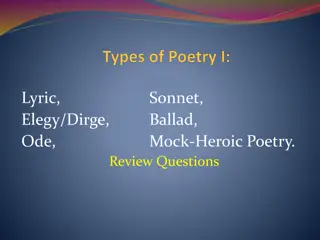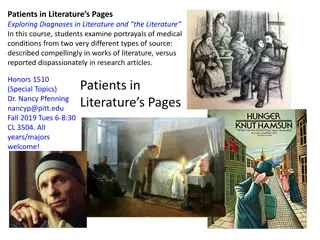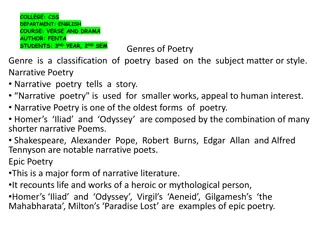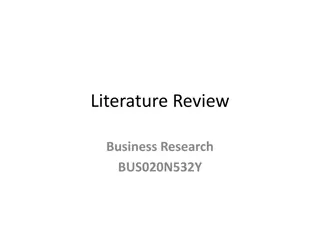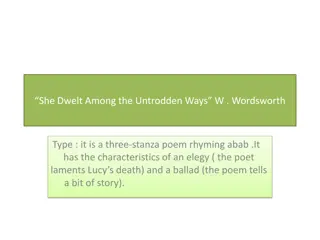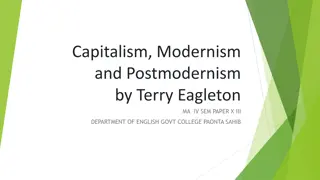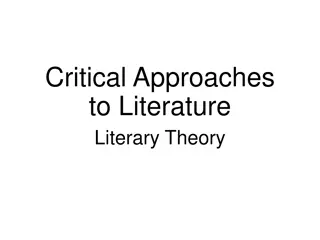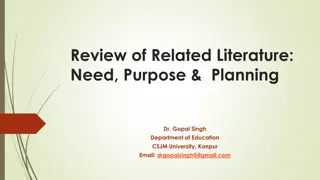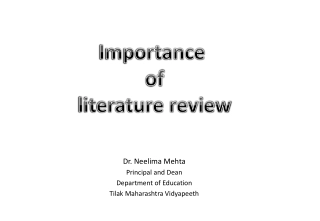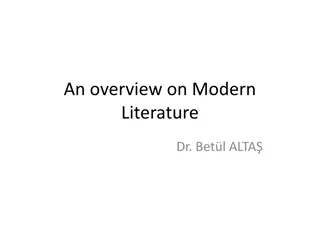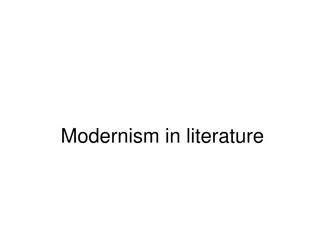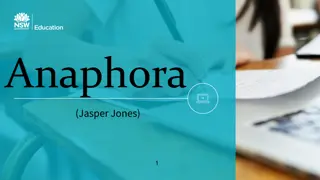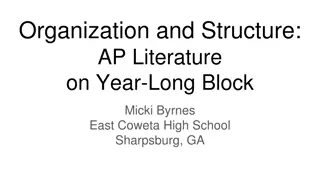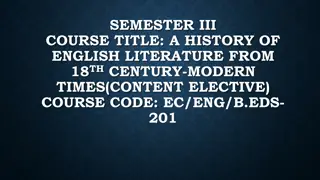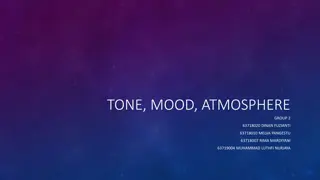Understanding Elegy in Literature: Features and Examples
Elegy in literature is a poetic form that honors the deceased, often lamenting their passing. This article explores the features of elegies, such as invoking the muse, questioning fate, and offering comfort. Examples from renowned poets like W.H. Auden and Walt Whitman showcase the emotional depth and varied expressions of elegiac poetry.
Download Presentation

Please find below an Image/Link to download the presentation.
The content on the website is provided AS IS for your information and personal use only. It may not be sold, licensed, or shared on other websites without obtaining consent from the author. Download presentation by click this link. If you encounter any issues during the download, it is possible that the publisher has removed the file from their server.
E N D
Presentation Transcript
K.DEEPA ASSISTANT PROFESSOR OF ENGLISH BON SECOURS COLLEGE FOR WOMEN THANJAVUR.
Elegy Definition Elegy is a form of literature that can be defined as a poem or song in the form of elegiac couplets, written in honor of someone deceased. It typically laments or mourns the death of the individual. Elegy is derived from the Greek work elegus, which means a song of bereavement sung along with a flute. The forms of elegy we see today were introduced in the 16th century. Elegy Written in a Country Churchyard, by Thomas Gray, and When Lilacs Last in the Dooryard Bloom d, by Walt Whitman are the two most popular examples of elegy.
Features of Elegy Usually, elegies are identified by several characteristics of genre: Just like a classical epic, an elegy typically starts with the invocation of the muse, and then proceeds by referencing traditional mythology. It often involves a poet who knows how to phrase thoughts imaginatively in the first person. Questions are raised by the poet about destiny, justice, and fate. The poet associates the events of the deceased with events in his own life by drawing a subtle comparison. This kind of digression gives the poet space to go beyond the main or crude subject to a deeper level where the connotations might be metaphorical. Towards the end the poet generally tries to provide comfort to ease the pain of the situation. Christian elegies usually proceed from sorrow and misery, to hope and happiness because they say that death is just a hindrance in the way of passing from the mortal state into the eternal state. An elegy is not always based on a plot.
Examples of Elegy from Literature Example #1: In Memory of W. B. Yeats (By W. H. Auden) With the farming of a verse Make a vineyard of the curse, Sing of human unsuccess In a rapture of distress; In the deserts of the heart Let the healing fountain start, In the prison of his days Teach the free man how to praise.
Example #2: O Captain! My Captain! (By Walt Whitman) O CAPTAIN! My Captain! our fearful trip is done; The ship has weather d every rack, the prize we sought is won; The port is near, the bells I hear, the people all exulting, While follow eyes the steady keel, the vessel grim and daring: But O heart! Heart! Heart! O the bleeding drops of red, Where on the deck my Captain lies, Fallen cold and dead.O Captain! My Captain! rise up and hear the bells; Rise up for you the flag is flung for you the bugle trills; 10 For you bouquets and ribbon d wreaths for you the shores a-crowding; For you they call, the swaying mass, their eager faces turning; Here Captain! Dear father! This arm beneath your head; It is some dream that on the deck, You ve fallen cold and dead. My Captain does not answer, his lips are pale and still; My father does not feel my arm, he has no pulse nor will; The ship is anchor d safe and sound, its voyage closed and done; From fearful trip, the victor ship, comes in with objectwon; 20 Exult, O shores, and ring, O bells! But I, with mournful tread, Walk the deck my Captain lies, Fallen cold and dead. Whitman wrote this elegy for Abraham Lincoln (16th president of the United States).
Function of Elegy Elegy is one of the richest literary forms because it has the capacity to express emotions that deeply influence people. The strongest of the tools elegy uses is its reliance on memories of those who are no more. Most of the poets who wrote elegies were evidently awed by the frailty of human beings, and how the world completely forgets about the deceased at some point. However, the function of elegy is not as limited as it is thought. Whenever we take a look at elegy examples, what comes to mind are feelings like sorrow, grief, and lamentation; but, a study of the Latin elegy tells us otherwise. A great deal of genre created in western literature was inspired by Latin elegy, which was not always so somber. The most famous elegiac poets in Latin literature, such as Catullus, Ovid, and Propertius, used humor, irony, even slotted narratives into a poem and still called them elegy.
Characteristics It is a type of lyric & focuses on expressing emotions or thoughts. It uses formal language & structure. It may mourn the passing of life & beauty or someone dear to the speaker. It may explore questions about nature of life & death or immorality of soul. It may express the speaker s anger about death.
An elegy is not same as a eulogy which is a statement written in prose that is read aloud at a funeral, although an elegy might serve as a eulogy. Three elements are found in a traditional elegy- Firstly, it begins with mourn, a grief at the loss of something or someone. In the second stage, the poet shows admiration, listing qualities & impressive deeds in the person s lifetime. The poem then moves to the third stage of consolidation. This last element may be more religious. An elegy may be of different kinds-personal, impersonal or pastoral. Pastoral elegy represents both the poet & the one he mourns for-who is usually also a poet-as Shepherds. In Pastoral Elegies like Lycidas , Milton mourns in the grief of a shepherd.
What is Pastoral Elegy? An elegy is a poem on the death of someone. And pastoral suggest that the elegy is related to 'shepherd', and rustic life. Pastoral elegies are poems in which the poet speaks in the guise of a shepherd in a peaceful landscape and expresses his grief on the death of another shepherd. The pastoral is the form of poetry that deals with the urban poets nostalgic image of the peace and simplicity of the life of shepherds and other rural folk in an idealized natural setting. Classical poets described the pastoral life as possessing features of mythical golden age . But Christian pastoralists, like Milton himself, have combined the golden age of the pagan fables with the Garden of Eden so that religious symbolism could also be exploited especially Christ as shepherd and people as sheep. Pastoral poems other than the elegiac ones deal with the beautiful, harmonious and pleasing atmosphere and life. The pastoral background to an elegiac poem serves to highlight the intensity of grief against a peaceful and pleasing atmosphere and pattern of life where death disrupts it all. Thus the pastoral elegy borrows images, allusions and even the setting from the pastoral world of antiquity. The pastoral elegy has a tradition going back to its earliest known writer Bion through Arnold, Shelley, Milton, Spenser, Petrarch, Virgil, Theocritus, and Moschus. Besides the personal grief of the individual shepherd-poet, the pastoral elegy says something about the world as a whole.
Explanation of Pastoral poetry Pastoral poetry is a genre that typically relates to country/rural life and often depicts the lives of shepherds. This sort of poetry describes the simple and pure lives of shepherds, who exist free from the corruptions of city life. Rural life is depicted as being pure in pastoral poetry and is usually idealized. The most common themes that are written about in pastoral poetry are love and death, although religion, politics, and other social issues are common as well. Often, the poet and his friends are represented by the characters in the poem. Through these characters, the poet expresses his or her own social, moral, political, and literary views. Pastoral poetry was first introduced by the Greek poet Theocritus in his Idylls. Set in the countryside, his poems reflect on folk traditions and involve dialogue between shepherds. This style of poetry was later adapted by the Roman poet Virgil, who frequently set his poems in Arcadia. Over time, the genre was adapted by a variety of different poets to include various themes, including romance, drama, courtship, seduction, and death. One of the most popular subgroups of pastoral poetry is the elegy, in which the poet mourns the death of a friend, often a fellow shepherd. Eventually, pastoral poetry became popular among English poets, especially through Edmund Spenser's The Shepherd s Calendar, which was published in 1579. One of the most famous examples of pastoral poetry is John Milton's Lycidas. Written in 1637, the poem is written about Edward King, a fellow student of Milton's who had died
Historical overview History of pastoral poetry Pastoral elegy, a subcategory of the elegy form of poetry, has its roots in Hellenistic Greek poetry of the 3rd and 2nd centuries BCE. Pastoral poetry itself, which deals heavily with shepherds and other forms of rustic life, dates back to the 3rd century BC when Theocritus, a Greek poet, wrote his idylls about rustic life in Sicily. The Roman poet Virgil was known for writing poems that depicted his sophisticated colleagues and himself as shepherds in simple, rustic settings. Virgil was also the first poet to set his elegies in Arcadia, a favorite location of pastoral literature to come. Developed over centuries, pastoral elegies mourn a subject by representing the mourner and the subject as shepherds. Shakespeare and his contemporaries were known to imitate some of the conventions of traditional pastoral poetry, and many hundreds of years later, the pastoral elegy was still practiced by 19th-century Romantic and Victorian poets.[6] History of elegies In classic literature, an elegy was simply any poem written in elegiac meter and was not restricted by its subject. Elegiac meter was considered alternating lines of dactylic hexameter and pentameter. Most classical elegies were actually love poems, not laments. In English literature since the 16th century CE, the elegy has come to mean specifically a poem of lamentation. Additionally, it may be written in any meter the poet chooses.[7]
The pastoral elegy in contemporary poetry Pastoral elegy poetry flourished in Europe between the Renaissance and the 19th century. However, modern poets, such as J.V. Cunningham and Alan Dugan, have re-imaged the elegy in both subject and form, and pastoral elegies have recently shown up in more satirical forms. However, other modern poets, such as William Carlos Williams and W. H. Auden, have written poems that maintain the traditional form and features of the pastoral elegy. Andrew Hudgins has an interesting elegy in which he mourns the lonely gap that exists between him and his still-living father. The poem is considered an elegy in the original sense of the Greek word elegeia, because it laments the fact that the father and son diverge in life, so they will most likely diverge in death as well. Though in its prime, the pastoral elegy had wide appeal, it is now sometimes considered dead.
Examples of definitive pastoral elegies Lycidas Written by John Milton, "Lycidas" is a pastoral elegy that first appeared in a 1638 collection of elegies in English and Latin entitled Justa Edouardo King Naufrago. Lycidas serves as Milton's commemoration of his Cambridge college mate, Edward King, who drowned when his ship sank off the coast of Wales in August 1637.[ In the poem, Milton gives King the name Lycidas, a common name for shepherds in the pastoral poetry of both Theocritus and Virgil. King was both a poet and an aspiring minister, who had died on his way to Ireland to take up a religious posting. Milton uses the shepherd's traditional association with both the poet and the minister to portray the death of King as a grievous waste of poetic and spiritual potential. Milton's persona is the "uncouth swain," a rustic shepherd with lofty poetic aspirations. The poet engages intensely with the pastoral tradition as he works through the crisis King's death evidently posed for him, considering the similarities between Milton and King. In its opening, "Lycidas" reflects the typical pastoral image of nature and country life tarnished by death. The swain describes seeing laurels and Myrtle brown, with ivy never-sear, an image of peace and tranquility that is disturbed when the speaker announces the death of Lycidas. This marks the beginning of the elegy and its subsequent presence throughout the poem. The poem rehearses the typical conventions of the pastoral elegy: nature's lament, the questioning of nymphs, repeated invocations of the muses, descriptions of flowers, and an apotheosis of the deceased. A series of other speakers interrupt the swain's mourning to interject their own thoughts and concerns into the poem. These speakers include Phoebus, the classical sun god, who also represents poetry; and "the pilot of the Galilean Sea," St. Peter, whose "dread voice" momentarily banishes the pastoral mood of the poem while prophesying against the "corrupted clergy" of the Laudian church in England. The balance between conventional pastoral imagery and these other elements has, over time, created the impression that Lycidas is one of the most innovative pastoral elegies. In "The Life of Milton," the 18th-century literary critic and polymath Samuel Johnson infamously called the pastoral form "easy, vulgar, and therefore disgusting," and said of "Lycidas": It is not to be considered as the effusion of real passion; for passion runs not after remote allusions and obscure opinions. Passion plucks no berries from the myrtle and ivy, nor calls upon Arethuse and Mincius, nor tells of rough satyrs and fauns with cloven heel. Where there is leisure for fiction there is little grief.[12] Johnson was reacting to what he saw as the irrelevance of the pastoral idiom in Milton's age and his own, and to its ineffectiveness at conveying genuine emotion. Johnson said that conventional pastoral images for instance, the representation of the speaker and the deceased as shepherds were "long ago exhausted," and so improbable that they "always forces dissatisfaction on the mind." Johnson also criticized the blending of Christian and pagan images and themes in "Lyciads," which he saw as the poem's "grosser fault." He said "Lycidas" positions the trifling fictions of heathen deities Jove and Pheobus, Neptune and olus alongside the most awful and sacred truths, such as ought never to be polluted with such irreverend combinations. Johnson concludes: "Surely no man could have fancied that he read Lycidas with pleasure had he not known its author.
Adonas Percy Bysshe Shelley's Adona s is a pastoral elegy written by Shelley immediately after hearing about the death of John Keats. The elegy is 495 lines long, consisting of a total of 55 Spenserian stanzas. Adona s was composed during the spring of 1821 and was eventually published in July 1821. Studying the works of many classical pastoral elegies himself, Shelley admired Milton's poetic voice and form in Lycidas. Thus, Shelley composed Adona s specifically in the tradition of Milton's Lycidas. Introduced to each other by their mutual friend Leigh Hunt in late 1816, Shelley and Keats often exchanged letters of advice about their works of poetry. With the maturation of Keats's genius, Shelly eventually became a devout and enthusiastic admirer of Keats. Keats's eventual illness, believed by Shelley to be directly related to the harsh criticism and negative reviews of Keats's poetry, prompted Shelley to invite Keats to stay with him in Italy. Keats declined Shelley's request, traveling instead with his companion Joseph Severn. Later proven to be suffering from tuberculosis, Keats died on February 23, 1821. Mourning the death of his friend, Shelley's grief is captured in the first stanza of the poem where the death of Adona s, who represents Keats, is announced. Shelley's grief is also palpable in the subsequent mourning. "I weep for Adona s - he is dead! Oh, weep for Adona s! though our tears Thaw not the frost which binds so dear a head! And thou, sad Hour, selected from all years To mourn our loss, rouse thy obscure compeers, And teach them thine own sorrow, say: With me Died Adona s; till the Future dares Forget the Past, his fate and fame shall be An echo and a light unto eternity!" Thyrsis Written by Matthew Arnold in December 1865, Thyrsis is a personal elegy that mourns the death of Matthew's friend Arthur Hugh Clough. Clough died in November 1861 at the age of 42. The poem's plot revolves around the main character Thyrsis, a shepherd in Virgil's seventh Eclogue, who loses a singing match against Corydon. Matthew Arnold's character Thyrsis represents Matthew's friend Arthur Clough. Keeping with the tradition of pastoral elegy poetry, Arnold displays pastoral elements in the poem as he describes the nature surrounding Oxford.
Literary criticism The pastoral is a literary style that presents a conventionalized picture of rural life, the naturalness and innocence of which is seen in contrast to the corruption and artificiality of city and court. Although pastoral works are written from the point of view of shepherds or rustics, they are always penned by highly sophisticated, urban poets. Some of the criticism towards this genre stems from its tensions between nature and art, the real and the ideal, and the actual and the mythical. English Renaissance pastoral has classical roots, but contains distinctly contemporary English elements, including humanism, sentimentality, depictions of courtly reality, a concern with real life, and the use of satire and comedy.






